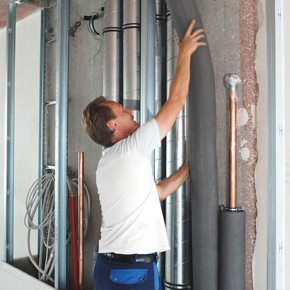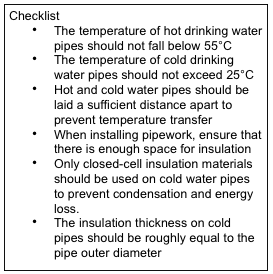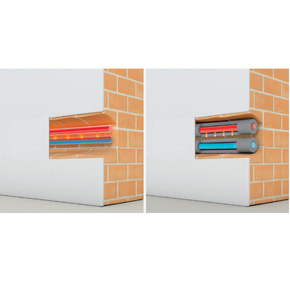
How to reduce the risk of legionella
Anthony Barnett of Armacell looks at the health benefits of using closed-cell insulation, including reducing the risk of legionella.
Legionnaries’ disease is a severe form of pneumonia that is transmitted through pathogens in water. Common sources of infection include contaminated air-conditioners, swimming pools and cooling towers, with estimates varying between 10,000 and 20,000 cases each year.
 The disease is contracted by inhaling airborne water droplets, which can be created by hot and cold water outlets, atomisers, showers and wet air conditioning plant.
The disease is contracted by inhaling airborne water droplets, which can be created by hot and cold water outlets, atomisers, showers and wet air conditioning plant.
The bacteria multiplies where water temperatures sit between 20-45°C and nutrients are available. However, legionnaires’ bacteria is dormant below 20°C and cannot survive above 60°C.
The risk of legionella therefore rises during the summer period as water stagnates in the pipes and the water temperatures rise, making HVAC and plumbing systems an ideal breeding ground for harmful bacteria.
Legionnaires’ bacteria is a particular concern in hospitals schools and care homes, as it usually affects those who are old, have pre-existing conditions or suffer with immunosuppression.
100% insulation
One of the most effective measures for reducing the risk of Legionnaires’ disease is to insulate both hot and cold water pipes using suitable materials, as poorly chosen insulation can result in the HVAC system operating in optimum conditions for the bacteria to breed.
 To tackle this issue, it is important to ensure that water circulates continuously through the pipework and does not drop below 45°C in hot water pipes. Likewise, water in cold water pipes should not rise above 40°C.
To tackle this issue, it is important to ensure that water circulates continuously through the pipework and does not drop below 45°C in hot water pipes. Likewise, water in cold water pipes should not rise above 40°C.
Cold water pipes should also be protected against heat gain by ensuring sufficient clearance or preferably by insulating properly. Similar requirements apply for hot water pipes to protect them against heat loss.
When hot and cold pipes are laid in one duct or wall cavity, or wherever water is not circulated regularly, it is recommended that ‘100% insulation’ is used.
100% insulation is where the insulation thickness corresponds to the pipework outer diameter. On hot water pipes, this helps to prevent legionella and protects the pipes against unnecessary energy losses. On cold water pipes, 100% insulation offers protection against freezing in cold weather conditions and provides protection against unwanted temperature rises.
Specifying the correct insulation material also prevents condensation. Armacell recommends closed-cell insulation for this as it offers a high resistance to water vapour diffusion, making it ideal for use on cold drinking water pipes.
In practice accidental damage to insulation has shown that open-cell insulation materials do not prevent moisture ingress as a result of diffusion.
This means that there is a risk of airborne water vapour penetrating the insulation, condensing and saturating the insulation material. As the material dampens, the thermal conductivity increases and insulation properties deteriorate, causing greater energy losses. In addition, corrosion and other damages can also occur.
Closed-cell insulation
Closed-cell insulation with anti-microbial protection is proven to prevent unwanted increases or decreases in water temperature. The closed-cell material structure of the insulation also prevents energy losses, moisture ingress and the subsequent corrosion of heating and plumbing pipework.
This makes it ideal in the prevention of legionnaires’ disease.
Armacell
Mars Street
Oldham
Oldham
Lancashire
OL9 6LY
UK
0161 287 7000
Visit Supplier's page
Latest news

18th April 2024
Abloy UK showcases new digital portfolio at The Security Event 2024
Abloy UK is set to unveil its latest line-up of access control systems at The Security Event 2024, welcoming guests to explore its cutting-edge electromechanical and digital solutions on stand 5/F50.
Posted in Access Control & Door Entry Systems, Architectural Ironmongery, Articles, Building Industry Events, Building Industry News, Building Products & Structures, Building Services, Doors, Exhibitions and Conferences, Facility Management & Building Services, Health & Safety, Information Technology, Retrofit & Renovation, Security and Fire Protection
18th April 2024
Strand is a Failsafe Choice for Emergency Exit and Panic Hardware
In times of emergency, you’re in safe hands with Strand Hardware. Although there are many considerations for building specification, few decisions can be as critical as selecting the right emergency exit/panic hardware.
Posted in Access Control & Door Entry Systems, Architectural Ironmongery, Articles, Building Industry News, Building Products & Structures, Building Services, Doors, Facility Management & Building Services, Health & Safety, Restoration & Refurbishment, Retrofit & Renovation, Security and Fire Protection
18th April 2024
MRA appoints Callum Budd as Research Projects Director
MRA Research, the research agency focused solely on the construction sector, welcomes Callum Budd as its new Research Projects Director.
Posted in Articles, Building Industry News, Information Technology, news, Recruitment, Research & Materials Testing
16th April 2024
Mitsubishi Electric set to host CIBSE Journal webinar
Mitsubishi Electric will host a CIBSE Journal webinar on Wednesday 24th April 2024 at 1pm to discuss the legislation and initiatives driving changes in the way we will need to heat, cool and ventilate large commercial buildings to reach net zero emissions in the UK.
Posted in Air Conditioning, Articles, Building Industry Events, Building Industry News, Building Products & Structures, Building Regulations & Accreditations, Building Services, Facility Management & Building Services, Heating Systems, Controls and Management, Heating, Ventilation and Air Conditioning - HVAC, Information Technology, Pipes & Fittings, Plumbing, Seminars, Sustainability & Energy Efficiency, Training
 Sign up:
Sign up: